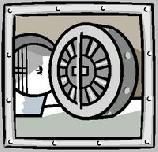
 |
|
| Financial Terms | |
| Markup |
|
Information about financial, finance, business, accounting, payroll, inventory, investment, money, inventory control, stock trading, financial advisor, tax advisor, credit.
Main Page: finance, stock trading, inventory control, financial, money, tax advisor, investment, business, |
Definition of Markup
MarkupAn increase in the cost of a product to arrive at its selling price. markupthe period after an announcement of a takeover bid in which stock prices typically rise until a merger or acquisition is made (or until it falls through).
Related Terms:inventory write-downRefers to making an entry, usually at the close of a Blanket inventory lienA secured loan that gives the lender a lien against all the borrower's inventories. Builder buydown loanA mortgage loan on newly developed property that the builder subsidizes during the BuydownsMortgages in which monthly payments consist of principal and interest, with portions of these CramdownThe ability of the bankruptcy court to confirm a plan of reorganization over the objections of Days' sales in inventory ratioThe average number of days' worth of sales that is held in inventory.  Down-and-in optionBarrier option that comes into existence if asset price hits a barrier. Down-and-out optionBarrier option that expires if asset price hits a barrier. DowngradeA classic negative change in ratings for a stock, and or other rated security. InventoryFor companies: Raw materials, items available for sale or in the process of being made ready for Inventory loanA secured short-term loan to purchase inventory. The three basic forms are a blanket Inventory turnoverThe ratio of annual sales to average inventory which measures the speed that inventory Just-in-time inventory systemsSystems that schedule materials/inventory to arrive exactly as they are Option writerOption seller. PaydownIn a Treasury refunding, the amount by which the par value of the securities maturing exceeds that  Top-down equity management styleA management style that begins with an assessment of the overall UnderwriteTo guarantee, as to guarantee the issuer of securities a specified price by entering into a purchase UnderwriterA party that guarantees the proceeds to the firm from a security sale, thereby in effect taking Write-downDecreasing the book value of an asset if its book value is overstated compared to current market values. WriterThe seller of an option, usually an individual, bank, or company, that issues the option and INVENTORY TURNOVERThe number of times a company sold out and replaced its average stock of goods in a year. The formula is: MERCHANDISE INVENTORYThe value of the products that a retailing or wholesaling company intends to resell for a profit. InventoryGoods bought or manufactured for resale but as yet unsold, comprising raw materials, work-in-progress and finished goods. Direct write-off methodA method of adjusting accounts receivable to the amount that is expected to be collected by eliminating the account balances of specific nonpaying customers. InventoryThe cost of the goods that a company has available for resale. Periodic inventory systemAn inventory system in which the balance in the inventory account is adjusted for the units sold only at the end of the period.  Perpetual inventory systemAn inventory system in which the balance in the inventory account is adjusted for the units sold each time a sale is made. inventory shrinkageA term describing the loss of products from inventory inventory turnover ratioThe cost-of-goods-sold expense for a given Inventory Turnover RatioProvides a measure of how often a company's inventory is sold or dollar days (of inventory)a measurement of the value of inventory for the time that inventory is held downsizingany management action that reduces employment vendor-managed inventorya streamlined system of inventory Average inventoryThe beginning inventory for a period, plus the amount at the end of Book inventoryThe amount of money invested in inventory, as per a company’s Finished goods inventoryGoods that have been completed by the manufacturing Moving average inventory methodAn inventory costing methodology that calls for the re-calculation of the average cost of all parts in stock after every purchase. Perpetual inventoryA system that continually tracks all additions to and deletions Raw materials inventoryThe total cost of all component parts currently in stock that Work-in-process inventoryinventory that has been partially converted through the Write offThe transfer of some or all of the contents of an asset account into an expense underwriterFirm that buys an issue of securities from a company and resells it to the public. InventoryGoods that a firm stores in anticipation of its later sale or use as an input. UnderwriterSee investment banker. Average-Cost Inventory MethodThe inventory cost-flow assumption that assigns the average First-In, First-Out (FIFO) Inventory MethodThe inventory cost-flow assumption that InventoryThe cost of unsold goods that are held for sale in the ordinary course of business or Inventory DaysThe number of days it would take to sell the ending balance in inventory at the Inventory ShrinkageA shortfall between inventory based on actual physical counts and inventory Last-In, First-Out (LIFO) Inventory MethodThe inventory cost-flow assumption that assigns the most recent inventory acquisition costs to cost of goods sold. The earliest inventory Write-DownA reduction in the balance-sheet valuation of an asset with an accompanying ABC inventory classificationA method for dividing inventory into classifications, Distribution inventoryinventory intended for shipment to customers, usually Ending inventoryThe dollar value or unit total of goods on hand at the end of an Finished goods inventoryCompleted inventory items ready for shipment to Fluctuation inventoryExcess inventory kept on hand to provide a buffer against Hedge inventoryExcess inventories kept on hand as a buffer against contingent Inactive inventoryParts with no recent prior or forecasted usage. In-transit inventoryinventory currently situated between its shipment and delivery InventoryThose items included categorized as either raw materials, work-inprocess, Inventory adjustmentA transaction used to adjust the book balance of an inventory Inventory diversionThe redirection of parts or finished goods away from their intended Inventory issueA transaction used to record the reduction in inventory from a location, Inventory receiptThe arrival of an inventory delivery from a supplier or other Inventory returnsinventory returned from a customer for any reason. This receipt Inventory turnoverThe number of times per year that an entire inventory or a Maximum inventoryAn inventory item’s budgeted maximum inventory level, Minimum inventoryAn inventory item’s budgeted minimum inventory level. Net inventoryThe current inventory balance, less allocated or reserved items. Obsolete inventoryParts not used in any current end product. Periodic inventoryA physical inventory count taken on a repetitive basis. Perpetual inventoryA manual or automated inventory tracking system in which Physical inventoryA manual count of the on-hand inventory. Reconciling inventoryThe process of comparing book to actual inventory balances, Seasonal inventoryVery high inventory levels built up in anticipation of large Surplus inventoryParts for which the on-hand quantity exceeds forecasted Vendor-managed inventoryThe direct management and ownership of selected UnderwriterThis could be the person (broker or agent) who helps you choose the proper type of life insurance or disability insurance and the insurance company for your particular needs. This could also be the person at the insurance company's head office who reviews your application for coverage to determine whether or not the insurance company will issue a policy to you. Inventory TurnoverRatio of annual sales to inventory, which shows how many times the inventory of a firm is sold and replaced during an accounting period. Life UnderwriterInsurance Agent. UnderwriterPerson that uses various types of evidence to evaluate the insurability of a client. Restructuring ChargeA special, nonrecurring charge taken in conjunction with a consolidation Related to : financial, finance, business, accounting, payroll, inventory, investment, money, inventory control, stock trading, financial advisor, tax advisor, credit. |